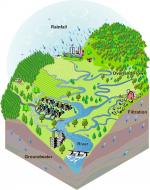|
This section contains 835 words (approx. 3 pages at 300 words per page) |

|
Environmental monitoring detects changes in the health of an ecosystem and indicates whether conditions are improving, stable, or deteriorating. This quality, too large to gauge as a whole, is assessed by measuring indicators, which represent more complex characteristics. The concentration of sulfur dioxide, for example, is an indicator that reflects the presence of other air pollutants. The abundance of a predator indicates the health of the larger environment. Other indicators include metabolism, population, community, and landscape. All changes are compared to an ideal, pristine ecosystem. The SER (stressor-exposure-response) model, a simple but widely used tool in environmental monitoring, classifies indicators as one of three related types:
- Stressors, which are agents of change associated with physical, chemical, or biological constraints on environmental processes and integrity. Many stressors are caused by humans, such as air pollution, the use of pesticides and other toxic substances, or habitat change caused...
|
This section contains 835 words (approx. 3 pages at 300 words per page) |

|


